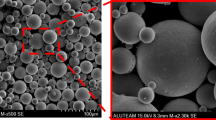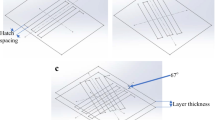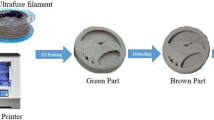Abstract
The success of laser-foil-printing (LFP) additive manufacturing depends critically on the laser welding of sheet metals onto the substrate or the previous layer during the part fabrication process. The welding can be generally categorized into two modes: conduction mode and keyhole mode. In this study, 304L stainless steel parts fabricated by the LFP process using the two laser welding modes are compared. The porosity, microstructure, and tensile properties of the fabricated parts in these two modes are measured and compared in the laser scanning direction (X) and part building direction (Z). The parts fabricated in the conduction mode have a higher density than those fabricated in the keyhole mode. On the tensile properties, both yield strength (YS) and ultimate tensile strength (UTS) have insignificant differences statistically based on the ANOVA analysis between the tensile specimens fabricated with the two welding modes by the LFP process. However, the conduction-mode parts have higher elongation than the keyhole-mode parts in both the X and Z directions, and the difference is especially significant in the Z direction. By using the electron backscattered diffraction (EBSD), it was found that the much higher ductility for the conduction-mode parts in the Z-axis direction is mainly due to the distinct grain boundary interface density in the Z-axis direction between the two welding modes.









Similar content being viewed by others
Data availability
The raw/processed data required to reproduce these findings will be made available on email request.
References
Blackburn J (2012) Laser welding of metals for aerospace and other applications. Woodhead Publishing Limited. https://doi.org/10.1533/9780857095169.1.75
Graudenz M, Baur M (2013) Application of laser welding in the automotive industry. Handb Laser Weld Technol:555–574. https://doi.org/10.1533/9780857098771.4.555
Lin TC, Cao C, Sokoluk M, Jiang L, Wang X, Schoenung JM, Lavernia EJ, Li X (2019) Aluminum with dispersed nanoparticles by laser additive manufacturing. Nat Commun 10:1–9. https://doi.org/10.1038/s41467-019-12047-2
Raghavan A, Wei HL, Palmer TA, DebRoy T (2013) Heat transfer and fluid flow in additive manufacturing. J Laser Appl 25:052006. https://doi.org/10.2351/1.4817788
Huang L, Hua X, Wu D, Ye Y (2019) Role of welding speed on keyhole-induced porosity formation based on experimental and numerical study in fiber laser welding of Al alloy. Int J Adv Manuf Technol 103:913–925. https://doi.org/10.1007/s00170-019-03502-x
Akman E, Demir A, Canel T, Sinmazçelik T (2009) Laser welding of Ti6Al4V titanium alloys. J Mater Process Technol 209:3705–3713. https://doi.org/10.1016/j.jmatprotec.2008.08.026
Meco S, Pardal G, Ganguly S, Williams S, McPherson N (2015) Application of laser in seam welding of dissimilar steel to aluminum joints for thick structural components. Opt Lasers Eng 67:22–30. https://doi.org/10.1016/j.optlaseng.2014.10.006
Torkamany MJ, Malek Ghaini F, Poursalehi R, Kaplan AFH (2016) Combination of laser keyhole and conduction welding: dissimilar laser welding of niobium and Ti-6Al-4V. Opt Lasers Eng 79:9–15. https://doi.org/10.1016/j.optlaseng.2015.11.001
Steen W, Mazumder J (2010) Basic laser optics. In: Laser material processing. Springer, London. https://doi.org/10.1007/978-1-84996-062-5_3
Steen W, Mazumder J (2010) Laser welding. In: Laser material processing. Springer, London. https://doi.org/10.1007/978-1-84996-062-5_5
Guo SH, Zou JL, Xiao RS (2020) Characterizations of welding mode transformation process during 1-μm and 10-μm laser welding. AIP Adv 10. https://doi.org/10.1063/1.5132776
Lee JY, Ko SH, Farson DF, Yoo CD (2002) Mechanism of keyhole formation and stability in stationary laser welding. J Phys D Appl Phys 35:1570–1576. https://doi.org/10.1088/0022-3727/35/13/320
Verhaeghe F, Craeghs T, Heulens J, Pandelaers L (2009) A pragmatic model for selective laser melting with evaporation. Acta Mater 57:6006–6012. https://doi.org/10.1016/j.actamat.2009.08.027
Tobar MJ, Lamas MI, Yáñez A, Sánchez-Amaya JM, Boukha Z, Botana FJ (2010) Experimental and simulation studies on laser conduction welding of AA5083 aluminum alloys. Phys Procedia 5:299–308. https://doi.org/10.1016/j.phpro.2010.08.056
Zhou J, Tsai HL, Wang PC (2006) Transport phenomena and keyhole dynamics during pulsed laser welding. J Heat Transf 128:680–690. https://doi.org/10.1115/1.2194043
Martin AA, Calta NP, Khairallah SA, Wang J, Depond PJ, Fong AY, Thampy V, Guss GM, Kiss AM, Stone KH, Tassone CJ, Weker JN, Toney MF, Buuren TV, Matthews MJ (2019) Dynamics of pore formation during laser powder bed fusion additive manufacturing. Nat Commun 10:1–10. https://doi.org/10.1038/s41467-019-10009-2
King WE, Barth HD, Castillo VM, Gallegos GF, Gibbs JW, Hahn DE, Kamath C, Rubenchik AM (2014) Observation of keyhole-mode laser melting in laser powder-bed fusion additive manufacturing. J Mater Process Technol 214:2915–2925. https://doi.org/10.1016/j.jmatprotec.2014.06.005
Hung CH, Chang FY (2017) Curve micromachining on the edges of nitinol biliary stent by ultrashort pulses laser. Opt Laser Technol 90:1–6. https://doi.org/10.1016/j.optlastec.2016.10.018
Kou S, Limmaneevichitr C, Wei PS (2011) Oscillatory Marangoni flow: a fundamental study by conduction-mode laser spot welding. Weld J 90(12):229s–240s
Antony K, Arivazhagan N (2015) Studies on energy penetration and Marangoni effect during laser melting process. J Eng Sci Technol 10:509–525
Sibillano T, Ancona A, Berardi V, Schingaro E, Basile G, Lugarà PM (2007) Optical detection of conduction/keyhole mode transition in laser welding. J Mater Process Technol 191:364–367. https://doi.org/10.1016/j.jmatprotec.2007.03.075
Bäuerle D (2011) Surface melting. In: Laser processing and chemistry. Springer, Berlin. https://doi.org/10.1007/978-3-642-17613-5_10
Metelkova J, Kinds Y, Kempen K, de Formanoir C, Witvrouw A, Van Hooreweder B (2018) On the influence of laser defocusing in selective laser melting of 316L. Addit Manuf 23:161–169. https://doi.org/10.1016/j.addma.2018.08.006
Yang J, Han J, Yu H, Yin J, Gao M, Wang Z, Zeng X (2016) Role of molten pool mode on formability, microstructure and mechanical properties of selective laser melted Ti-6Al-4V alloy. Mater Des 110:558–570. https://doi.org/10.1016/j.matdes.2016.08.036
Zafari A, Xia K (2018) High Ductility in a fully martensitic microstructure: a paradox in a Ti alloy produced by selective laser melting. Mater Res Lett 6:627–633. https://doi.org/10.1080/21663831.2018.1525773
Li Y, Shen Y, Leu MC, Tsai HL (2019) Mechanical properties of Zr-based bulk metallic glass parts fabricated by laser-foil-printing additive manufacturing. Mater Sci Eng A 743:404–411. https://doi.org/10.1016/j.msea.2018.11.056
Hung CH, Sutton A, Li Y, Shen Y, Tsai HL, Leu MC (2019) Enhanced mechanical properties for 304L stainless steel parts fabricated by laser-foil-printing additive manufacturing. J Manuf Process 45:438–446. https://doi.org/10.1016/j.jmapro.2019.07.030
Chen C, Shen Y, Tsai HL (2017) A foil-based additive manufacturing technology for metal parts. J Manuf Sci Eng Trans ASME 139:1–6. https://doi.org/10.1115/1.4034139
Hung CH, Li Y, Sutton A, Chen WT, Gong X, Pan H, Tsai HL, Leu MC (2020) Aluminum parts fabricated by laser-foil-printing additive manufacturing: processing, microstructure, and mechanical properties. Materials 13:414. https://doi.org/10.3390/ma13020414
Rai R, Elmer JW, Palmer TA, Debroy T (2007) Heat transfer and fluid flow during keyhole mode laser welding of tantalum, Ti-6Al-4V, 304L stainless steel and vanadium. J Phys D Appl Phys 40:5753–5766. https://doi.org/10.1088/0022-3727/40/18/037
Tepylo N, Huang X, Patnaik PC (2019) Laser-based additive manufacturing technologies for aerospace applications. Adv Eng Mater 21:1–35. https://doi.org/10.1002/adem.201900617
Bergström D (2008) The absorption of laser light by rough metal surfaces. Thesis 226
Graves RS, Kollie TG, McElroy DL, Gilchrist KE (1991) The thermal conductivity of AISI 304L stainless steel. Int J Thermophys 12:409–415. https://doi.org/10.1007/BF00500761
Dinda GP, Dasgupta AK, Bhattacharya S, Natu H, Dutta B, Mazumder J (2013) Microstructural characterization of laser-deposited Al 4047 Alloy. Metall Mater Trans A 44A:2233–2242. https://doi.org/10.1007/s11661-012-1560-3
ASTM (2013) E2627-13, Standard practice for determining average grain size using electron backscatter diffraction (EBSD) in fully recrystallized polycrystalline materials. ASTM International, West Conshohocken. https://doi.org/10.1520/E2627-13
ASTM (2017) E92-17, Standard test methods for Vickers hardness and Knoop hardness of metallic materials. ASTM International, West Conshohocken. https://doi.org/10.1520/E0092-17
Fu JW, Yang YS, Guo JJ, Tong WH (2008) Effect of cooling rate on solidification microstructures in AISI 304 stainless steel. Mater Sci Technol 24:941–944. https://doi.org/10.1179/174328408X295962
Ghayoor M, Lee K, He Y, Chang CH, Paul BK, Pasebani S (2020) Selective laser melting of 304L stainless steel: role of volumetric energy density on the microstructure, texture and mechanical properties. Addit Manuf 32:101011. https://doi.org/10.1016/j.addma.2019.101011
Conner RD, Choi-Yim H, Johnson WL (1999) Mechanical properties of Zr 57Nb5al10cu15.4Ni12.6 metallic glass matrix particulate composites. J Mater Res 14:3292–3297. https://doi.org/10.1557/JMR.1999.0445
Callister W (2007) Rethwisch D. Mater Sci Eng Introduction 94:188–190. https://doi.org/10.1016/0025-5416(87)90343-0
Wang H, Zou Y (2019) Microscale interaction between laser and metal powder in powder-bed additive manufacturing: conduction mode versus keyhole mode. Int J Heat Mass Transf 142:118473. https://doi.org/10.1016/j.ijheatmasstransfer.2019.118473
Acknowledgments
The help and suggestions of Dr. Hai-Lung Tsai on this research are highly appreciated.
Funding
This research work was supported by the Department of Energy (grant number DE-FE0012272) and by the Intelligent Systems Center at the Missouri University of Science and Technology.
Author information
Authors and Affiliations
Contributions
Chia-Hung Hung: conceptualization, methodology, investigation, formal analysis, writing—original draft; Wei-Ting Chen: methodology, validation, writing—review and editing; M. Hossein Sehhat: formal analysis, writing—review and editing; Ming C. Leu: supervision, funding acquisition, writing—review and editing
Corresponding author
Ethics declarations
Ethical approval
The manuscript contains original ideas which have never been published before in other journals.
Consent to participate
This study is not a human transplantation study. No consent needed for this paper.
Competing interests
The authors declare that they have no conflict of interest.
Additional information
Publisher’s note
Springer Nature remains neutral with regard to jurisdictional claims in published maps and institutional affiliations.
Rights and permissions
About this article
Cite this article
Hung, CH., Chen, WT., Sehhat, M.H. et al. The effect of laser welding modes on mechanical properties and microstructure of 304L stainless steel parts fabricated by laser-foil-printing additive manufacturing. Int J Adv Manuf Technol 112, 867–877 (2021). https://doi.org/10.1007/s00170-020-06402-7
Received:
Accepted:
Published:
Issue Date:
DOI: https://doi.org/10.1007/s00170-020-06402-7




